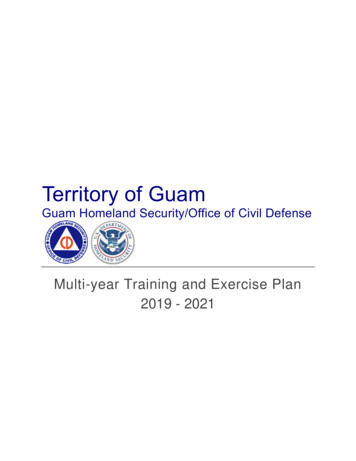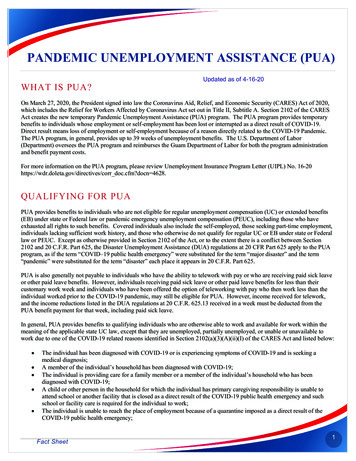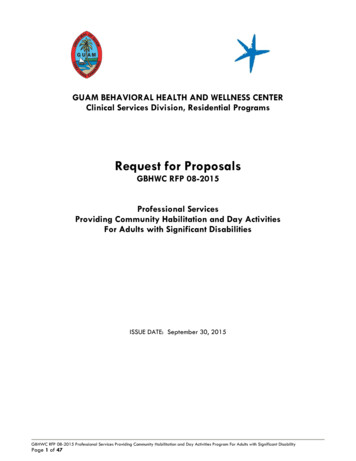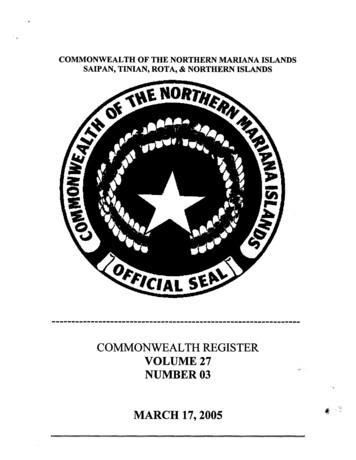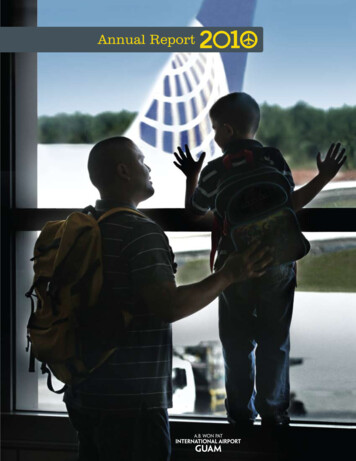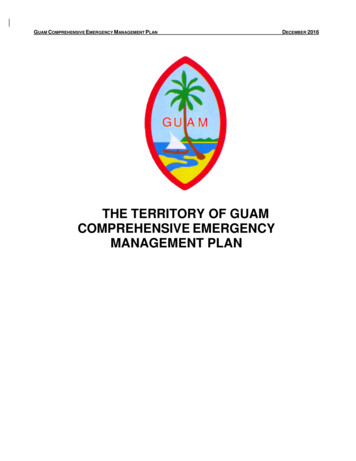
Transcription
GUAM COMPREHENSIVE EMERGENCY MANAGEMENT PLANTHE TERRITORY OF GUAMCOMPREHENSIVE EMERGENCYMANAGEMENT PLANDECEMBER 2016
GUAM COMPREHENSIVE EMERGENCY MANAGEMENT PLANDECEMBER 2016TABLE OF CONTENTSRECORD OF CHANGES . 6EXECUTIVE SUMMARY . 7I. INTRODUCTION . 7A. Comprehensive Emergency Management . 8B. All-Hazards Planning . 9C. Comprehensive Resource Planning. 10D. Catastrophic Planning . 10E. Information Support for Emergency Planning and Operations . 10F. The United States National Grid . 11G. Relationship to Other Plans . 11II. PURPOSE. 12III. SITUATION AND ASSUMPTIONS . 12A. Situation . 12B. Assumptions . 151. General Operational Assumptions . 152. Demographic Assumptions . 17IV. STATUTORY AND JURISDICTIONAL RESPONSIBILITIES . 18A. Village Mayors . 18B. Guam Homeland Security/Office of Civil Defense:. 19C. The Office of the Governor of Guam. 22D. The Federal Government . 22V. CONCEPT OF OPERATIONS . 22A. Emergency Operations Center Emergency Support Function (EOC ESF) Team . 23B. The Guam Emergency Operations Center . 24C. Direction and Control . 24D. Roles and Responsibilities . 25E. Emergency Powers . 271. Office of the Governor. 272. The Guam Homeland Security/Office of Civil Defense (GHS/OCD) . 283. Village Mayor’s Offices . 284. The Guam National Guard (GUNG) . 28F. Monitoring, Detection, Alert, and Warning . 291. EOC Staff Duty Officers/Duty Officer --- Normal Operation Staffing . 292. EOC Staff Duty Officers / EOC Director . 293. EOC Duty Officers(s) . 294. Communication Systems. 305. Alert and Warning . 306. Communication Interoperability . 30G. Emergency Declaration Process: Territorial and Federal Government. 321. Authority to Declare a State of Emergency . 322. Territory Emergency Declaration Process . 323. Presidential Emergency or Major Disaster Declaration . 33H. Activation of Emergency Facilities . 35BASIC PLAN, PAGE 3
GUAM COMPREHENSIVE EMERGENCY MANAGEMENT PLANDECEMBER 2016I. Resource Management . 351. Resource Typing . 352. Pre-positioning of Resources . 363. Resource Needs . 364. Village Resource Requests . 365. Private Sector Resources . 37J. Continuity of Government and Continuity of Operations . 37K. Protective Measures . 381. Evacuations . 382. Functional Needs Sheltering . 383. Sheltering Pets or Service Animals . 39L. Response Operations. 391. Emergency Operations Center Emergency Support Function (EOC ESF) TeamActivation . 392. Maintaining a Common Operating Picture . 403. Unified Command . 404. Integration of the Incident Command System (ICS) and Emergency Support Functions(ESFs) . 40M. Recovery Operations . 431. Transition from Response to Recovery. 432. Establishment of a Joint Field Office (JFO) . 433. Recovery Assistance Programs . 45N. Mitigation Operations . 471. Disaster Activity . 472. Hazard Mitigation Planning . 483. Hazard Mitigation Grant Program (HMGP) . 484. Non-Disaster Mitigation Grant Programs . 485. The National Flood Insurance Program (NFIP) . 48VI. ADMINISTRATION AND LOGISTICS . 48A. General Policies for Managing Resources . 48B. Mutual Aid . 49VII. PLAN DEVELOPMENT AND MAINTENANCE . 49A. Overall Approach to Plan Development . 49B. Exercise and Plan Revisions . 49C. HSEEP Compliance and Plan Improvement . 50D. Plan Review . 50VIII. LEGAL CONSIDERATIONS . 50A. Compliance with the Americans with Disabilities Act and other Laws or Guidelines forFunctional Needs Support Services (FNSS) . 50IX. REFERENCES AND AUTHORITIES . 51A. Laws . 511. Guam Statutes . 512. Federal Statutes. 51B. Administrative Rules . 52Code of Federal Regulations . 52C. Executive Orders . 53Federal. 53BASIC PLAN, PAGE 4
GUAM COMPREHENSIVE EMERGENCY MANAGEMENT PLANDECEMBER 2016D. Supporting Plans and Procedures . 53E. Supporting Annexes . 53ACRONYMS . 55FUNCTIONAL ANNEXES EMERGENCY SUPPORT FUNCTION ANNEX GUAM HOMELAND SECURITY/OFFICE OF CIVIL DEFENSE - EMERGENCY OPERATIONSCENTER CONTINUITY OF OPERATIONS (COOP) ANNEXINCIDENT S PECIFIC ANNEXES TROPICAL CYCLONE RESPONSE ANNEX TSUNAMI RESPONSE ANNEX TERRORISM / W EAPONS OF MASS DESTRUCTION (WMD) RESPONSE ANNEX AVIATION INCIDENT/ACCIDENT RESPONSE ANNEX PANDEMIC RESPONSE ANNEX THE EMERGENCY SUPPORT FUNCTION STANDARD OPERATING GUIDELINESBASIC PLAN, PAGE 5
GUAM COMPREHENSIVE EMERGENCY MANAGEMENT PLANDECEMBER 2016RECORD OF CHANGESDateDescription of ChangeBASIC PLAN, PAGE 6Page or Section
GUAM COMPREHENSIVE EMERGENCY MANAGEMENT PLANDECEMBER 2016EXECUTIVE SUMMARYPursuant to Guam Civil Defense Act of 1951, the Guam Comprehensive Emergency ManagementPlan (GUAM CEMP) is the master operations document for the Territory of Guam in responding toall emergencies, and all catastrophic, major, and minor disasters. The GUAM CEMP defines theresponsibilities of all levels of government, private, volunteer and non-governmental organizations(NGOs) that make up the Guam Emergency Operations Center Emergency Support Function(EOC ESF) Team. The GUAM CEMP also captures the authority and role of the federalgovernment in response to incidents and emergency events on Guam, including those which arepresidentially declared disasters. The GUAM CEMP ensures that all levels of government are ableto mobilize as a unified emergency organization to safeguard the well-being of Guam’s residentsand visitors. The GUAM CEMP is compliant with the National Incident Management System(NIMS), and incorporates the principles set forth in the Incident Command System (ICS). In 2004,Guam began utilizing NIMS as the standard procedure for incident management in the territory.Each employee of the Guam Homeland Security/Office of Civil Defense (GHS/OCD) and the EOCESF Team is required, through the Agency’s Training and Exercise Unit, to complete requiredNIMS training and other training as it relates to their emergency support function.The GUAM CEMP employs the strategic vision of Presidential Policy Directive 8 (PPD-8), tostrengthen resiliency by involving partners at all levels of government as well as with NGOs andthe private sector in the planning process. Additionally, the GUAM CEMP parallels federal activitiesset forth in the National Response Framework (NRF). The NRF details operating principles andprotocols for major disasters. Together, PPD-8, the NRF and NIMS integrate the resources ofjurisdictions, incident management and emergency response disciplines, NGOs, and the privatesector into a seamless national framework for domestic incident response.The 2016 revision of the GUAM CEMP represents the collective efforts of GHS/OCD and theGuam EOC ESF Team.I.INTRODUCTIONThe Guam Comprehensive Emergency Management Plan (GUAM CEMP) describes thebasic strategies, assumptions, operational objectives, and mechanisms through which theGuam Emergency Operations Center Emergency Support Function (EOC ESF) Team willmobilize resources and conduct activities to guide and support local emergency managementefforts through preparedness, response, recovery, and mitigation. To facilitate effectiveoperations, the GUAM CEMP adopts a functional approach that groups the types ofassistance to be provided into 16 Emergency Support Functions (ESFs), formerly known asResponse Activity Coordinators (RACs). Each ESF is headed by a primary agency selectedbased on its authorities, resources, and capabilities in that ESF’s functional area. The primaryagency appoints an Emergency Coordination Officer (ECO) to manage the ESF’s function inthe Emergency Operations Center (EOC). The ECOs and staff of GHS, other territorialagencies, and private volunteer organizations and non-governmental agencies form the EOCESF Team. The EOC ESF Team serves as the primary operational mechanism throughwhich assistance to local jurisdictions is managed. Assistance will be provided to impactedcommunities under the authority of the Territory Coordinating Officer (TCO), on behalf of theGovernor, as head of the EOC ESF Team. If the President of the United States issues anemergency or major disaster declaration for Guam, the TCO will coordinate federal assistanceisland wide through the Federal Coordinating Officer (FCO) and corresponding federalESF(s). The federal ESF organization will work with the Guam ESF structure to ensure thatresources and services are provided in a timely manner.BASIC PLAN, PAGE 7
GUAM COMPREHENSIVE EMERGENCY MANAGEMENT PLANDECEMBER 2016The GUAM CEMP is designed to be flexible, adaptable and scalable. It articulates the rolesand responsibilities among village, Government of Guam and federal emergency officials. Thisdocument supersedes the 2005 Guam Emergency Response Plan (GERP). The GUAMCEMP includes the Basic Plan and supplemental documents that will provide more detailedinformation to assist emergency management officials and others in implementing the CEMP.The GUAM CEMP is broken down as follows:1. Basic Plan: Describes the process for preparedness, response, recovery and mitigationactivities of federal, territorial, and local agencies, private volunteer organizations and nongovernmental organizations that form the EOC ESF Team.2. Emergency Support Function (ESF) Annex: This series of appendices describe the 16ESFs, which serve as the primary mechanisms for providing assistance at theGovernment of Guam level.3. Incident-Specific Annexes: These annexes address the unique aspects of how the Guamresponds to incident-specific emergencies and disasters.The nature of the emergency will dictate which plans and procedures are initiated. Once aspecific plan is activated, certain ESFs may have a greater role to play in response to theemergency than others.Why Emergency Planning is NecessaryAn emergency plan specifies procedures for managing response and recovery operations forspecific emergency events. The objective of the GUAM CEMP is to reduce the possibleconsequences of the emergency by preventing loss of life and injuries, reducing damage toinfrastructure, buildings and homes, and accelerating the resumption of normal daily lifeactivities.The GUAM CEMP incorporates the following planning concepts to develop a comprehensiveprogram for emergency management in the Territory of Guam:A. Comprehensive Emergency ManagementComprehensive emergency management involves a cycle of phased, coordinated andmutually supporting activities conducted by each level of government before, during, andafter an emergency situation, including: Prevention: The Territory of Guam’s prevention efforts focus on stopping an incidentfrom occurring, be they potential natural disasters, technological occurrences, orterrorist (both physical and biological) attacks. Activities that may be undertaken by theGovernment of Guam during this phase include: heightened inspections, improvedsurveillance and security operations; public health monitoring and testing; immunizations,isolation or quarantine; proscribed fires within wildland areas and forests; and any lawenforcement operations aimed at deterring, preempting, interdicting, or disruptingillegal activity. In most cases, the preventative or protective measures applied byGovernment of Guam agencies will occur in tandem with similar efforts undertakenby federal authorities Mitigation: The Territory of Guam’s mitigation effort helps to ensure that on-islandresidents, visitors and businesses are safe and secure from natural, technologicalBASIC PLAN, PAGE 8
GUAM COMPREHENSIVE EMERGENCY MANAGEMENT PLANDECEMBER 2016and man-made hazards by reducing the risk and vulnerability before a disasteroccurs. The territory’s mitigation efforts are parallel to those employed by the FederalEmergency Management Agency (FEMA) and include: enhancing and maintaining aterritory’s capacity to implement a comprehensive island wide Hazard Mitigation Plan,supporting the development and enhancement of local capability to practice hazardmitigation, increasing the public and private sector awareness of and support fordisaster loss education, reducing Guam’s hazard vulnerability through the applicationof scientific research and development, and reducing the vulnerabilities ofGovernment of Guam-owned facilities and infrastructure to natural and man-madehazards. Preparedness: Preparedness activities ensure both federal and local governmentorganizations, private sector and non-government organizations, residents and visitors, andall other stakeholders are ready to react promptly and effectively during anemergency. Preparedness activities include: obtaining information on threats,planning to prepare an organized response to emergencies, providing disasterpreparedness training for emergencies, conducting emergency drills and exercises totest plans and training effectiveness, obtaining and maintaining emergencyequipment and facilities, establishing intergovernmental coordination agreements,and conducting public education outreach. Response: Response includes those actions that must be carried out when anemergency exists or is imminent. Activities include: notifying key officials and warningthe public of emergency situations, activating emergency facilities, mobilizing,deploying, and employing personnel, equipment, and supplies to resolve theemergency situation, and providing emergency assistance to the affected localpopulation. Recovery: Recovery consists of short and long-term operations. Short-term recoveryoperations to restore vital services, such as electrical power, water, and sewersystems, telecommunications and commercial mobile radio services, clear roads inaffected areas, and provide emergency assistance to disaster survivors. Disasterrelief programs to help restore the personal, social, and economic wellbeing of privatecitizens are administered by non-profit disaster relief and charitable organizations, aswell as local, territorial and federal disaster relief programs. Long-term recoveryfocuses on restoring communities to a state of normality by assisting property ownersin repairing or rebuilding their homes and businesses and assisting localgovernments, school districts, and other public non-profit agencies in restoring orreconstructing damaged infrastructure. Territorial, local and non-governmentorganizations administer the provisions of federal and territorial disaster relief funds toprovide for restoration and recovery of vital facilities. Post-disaster mitigationprograms may also be implemented during the recovery period.B. All-Hazards PlanningEmergency planning in Guam uses an all-hazards approach. All-hazards planning isbased on the premise that the consequences of disasters are similar regardless of thehazard, and most of the functions performed during emergency situations are not hazardspecific. Hence, the most efficient approach to planning is to map out in some detail thetasks required to carry out basic emergency functions that may have to be executed,regardless of whether a disaster is caused by a natural, technological, or man-madehazard. Hazard-specific plans for unique threats are developed to supplement all-hazardsplans. Nonetheless, to better assist the agencies in the GUAM CEMP to successfullyexecute their missions, hazard specific annexes also will be included in this overall plan.BASIC PLAN, PAGE 9
GUAM COMPREHENSIVE EMERGENCY MANAGEMENT PLANDECEMBER 2016C. Comprehensive Resource PlanningComprehensive resource planning includes public, private sector and volunteer/nongovernmental (VOAD) resources and those private sector resources that can bereasonably expected to be made available, either on a voluntary or paid basis. Theseresources include industry and volunteer organizations, quasi-public resources, anddonations. Similarly both intrastate and interstate mutual aid resources and federalresource assistance will be considered, where appropriate. When resources are limited,plans address suspending, reducing, or deferring some government services so thatpersonnel, equipment, supplies, and facilities involved can be redirected to supportemergency operations.D. Catastrophic PlanningIn a catastrophic disaster, providing the same response faster or increasing the amount ofresources will not be sufficient to ensure a quick and efficient response. Due to their sizeand magnitude, catastrophic disasters require local, territorial, and federal agencies tohandle situations in ways that have not been traditionally used in the past.In order to effectively identify resource shortfalls, response capabilities and needs must bechecked against a scenario with given consequences. Guam utilizes scenario-basedresource planning to promote the development and/or improvement of operationalconcepts, protocols, plans, and decision tools that put capabilities and resource gaps incontext. The process can be used for any and all catastrophic or large scale disasters, asthe concepts developed are scalable and intended to address catastrophic responseregardless of hazard type, size/scope, or geographic location.Not all disasters are catastrophic in nature. Generally, Guam defines a catastrophicdisaster as one that results in the following: Requiring an extraordinary level of capabilities beyond the territorial, or nationalcapacities.A large number of victims or casualties.Extensive damage to or disruption of critical infrastructure.Significant dislocation of the island’s population from their communities of origin,resulting in the need to designate host communities.Substantial degradation of Guam’s environment.Destabilization of the island’s economy.Instability of local government.E. Information Support for Emergency Planning and OperationsThe emergency planning process develops the information and intelligence needed bothto produce viable plans and to conduct effective emergency operations. This effortincludes: An accurate analysis of natural, technological, and man-made hazards;descriptions and/or maps of possible impact areas; and information on thecharacteristics of such areas. Estimates of the potential effects that hazards impose on people and property, andwhere appropriate, tools to conduct dynamic assessments of such threats.A list of critical infrastructure, which typically includes both public and private BASIC PLAN, PAGE 10
GUAM COMPREHENSIVE EMERGENCY MANAGEMENT PLAN DECEMBER 2016sector facilities that are essential for security, public health and safety, or theeconomy.Resource data, including public resources and those industry and volunteer groupresources that can reasonably be expected to be available for emergency use.Necessary measures to obtain and share intelligence and operational informationessential to conducting effective emergency management operations with both thefederal and local governments. In maintaining situational awareness of foreign anddomestic threats, effective measures for safeguarding sensitive information must beestablished and maintained. Effective information sharing provides decisionmakers at all levels of government with a sound basis for making decisions toposture and commit resources, and implement plans and procedures.F. The United States National GridThe NAD 83 HARN (high accuracy reference network) and associated Guam Map gridwere updates to the older Guam Grid 1963 map projection and datum and Guam GridNAD 83. The NOAA National Geodetic Survey (NGS), and assistance of some localsurveying firms occupied survey points around the island to update the horizontal surveycontrols and later updated the benchmarks for the vertical control. This vertical controlwas important in the Lidar survey.The NAD83(HARN) / Guam Map Grid is a projected CRS last revised on in June 2011and is suitable for use in Guam - onshore. NAD83(HARN) / Guam Map Grid uses theNAD83(HARN) geographic 2D CRS as its base CRS and the Guam Map Grid(Transverse Mercator) as its projection. NAD83(HARN) / Guam Map Grid is a CRS forlarge and medium scale topographic mapping, cadastral and engineering survey. It wasdefined by information from Guam Public Law 23-31 and Department of LandManagement brochure "1993 Guam Geodetic Network" and it replaces Guam 1963 /SPCS (CRS code 3993) from 1995. Guam Public Law 23-31 uses the name "NAD83" forNAD83 (HARN). NAD83 is a system realized only in North America and different toNAD83 (HARN).G. Relationship to Other Plans Relationship to Other Territorial Plans: The GUAM CEMP is supported by a numberof specialized Government of Guam and federal plans such as the TacticalInteroperable Communications Plan, Guam Catastrophic Typhoon CONPLAN, 2011Guam Hazard Mitigation Plan, etc. Such plans are incorporated into the GUAM CEMPby reference and stored in the GHS/OCD digital reference library. Relationship to Federal Plans: The GUAM CEMP provides for integration ofterritorial response operations with the federal agencies responding to emergencysituations in Guam at the request of the Governor. This plan is consistent with FEMA’sGuam Catastrophic Typhoon OPLAN (Aug 2010), which is wholly incorporated intothis plan by reference. The GUAM CEMP also recognizes other regional planningefforts developed under the National Response Framework (NRF), which are stored inthe GHS/OCD digital reference library. Relationship to Interstate/Inter-island Agreements: The GUAM CEMP addressesprovisions for requesting emergency assistance from other states or providingemergency assistance to other states in accordance with the Emergency ManagementAssistance Compact (EMAC) and a number of specialized agreements to which Guamis a party.BASIC PLAN, PAGE 11
GUAM COMPREHENSIVE EMERGENCY MANAGEMENT PLANII.DECEMBER 2016PURPOSEThe purpose of Guam’s Comprehensive Emergency Management Plan (GUAM CEMP) is to: Develop an all-hazards planning approach that will be used for all threats to, and/oremergencies or disasters that may impact Guam. Create the general framework of planning for preparedness, response, recovery andmitigation activities within the territory. Reduce the vulnerability of people and their communities, including the loss of life orinjury, or the damage and loss of property resulting from natural, technological, andman-made disasters, by developing effective preparedness, response, recovery andmitigation plans. Describe the federal relationship during an emergency disaster, or event. Describe the types of disasters which are likely to occur in Guam, from localemergencies to minor, major or catastrophic disasters. Describe the actions that the Guam Emergency Operations Center Emergency SupportFun
occurs. The territory's mitigation efforts are parallel to those employed by the Federal Emergency Management Agency (FEMA) and include: enhancingand maintaining a territory's capacity to implement a comprehensive island wide Hazard Mitigation Plan, supportingthe developme nt and enhancement of local capability to practice hazard


